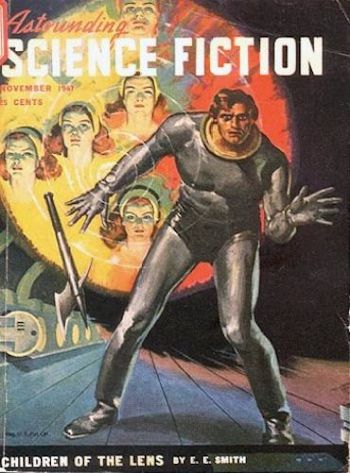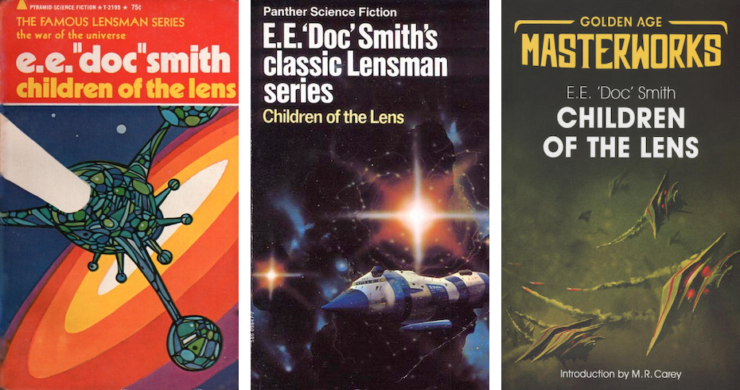In this bi-weekly series reviewing classic science fiction and fantasy books, Alan Brown looks at the front lines and frontiers of the field; books about soldiers and spacers, scientists and engineers, explorers and adventurers. Stories full of what Shakespeare used to refer to as “alarums and excursions”: battles, chases, clashes, and the stuff of excitement.
Holy Klono’s Gadolinium Guts! The Lensmen are back at work, and it’s a good thing, because evil is afoot. We’ve finished with the trilogy of books that followed the career of Lensman Second Stage Kimball Kinnison, but the series still has some gas in the tank. Kim and his fellow Lensmen, while getting a little long in the tooth, are still active. And the Kinnison family now has a bunch of kids, who are more than living up to the family tradition. Not so surprisingly (since it’s happened with every book of the series), the final boss battle of the last book turned out to be only another rung in the ladder of evil that is Boskone, and there is more work to be done…
This time around, the used copy I reviewed was a British edition from Panther Books, and the cover (above, center) is one of those generic spaceships that could have appeared on just about any science fiction book in the library. The artist was uncredited, but the style looks very familiar, and I’m sure someone will recognize the artist and I’ll be embarrassed I didn’t figure it out. In this case, that cover has held up better than the Astounding cover for Children of the Lens (seen further down in this article), which accurately represents the story, but is relatively crude in its execution, and not nearly as good as the illustrations the magazine gave to the other installments of the series.
Children of the Lens was plotted at the same time as the three books featuring Kimball Kinnison, and like those tales, first appeared in Astounding Science Fiction, in this case in 1947. It is the sixth of the Lensman books in chronological order. I’ve already reviewed prequel books Triplanetary and First Lensman, which covered the founding of the Lensmen and Galactic Patrol, and three previous adventures of Kimball Kinnison: Galactic Patrol, Gray Lensman, and Second Stage Lensmen. After Children of the Lens, I only have one more book from the series to review, The Vortex Blaster, which, while it is set in the Lensman universe, consists of adventures not connected to the main storyline. I’d missed out on reading these books in my youth, so this is my first visit to the world of the Lensmen.
And once more, I thank Julie at Fantasy Zone Comics and Used Books for finding copies of the Lensman books and making this review series possible.
About the Author
Edward Elmer Smith (1890-1965), often referred to as the “Father of Space Opera,” wrote under the pen name E. E. “Doc” Smith. I included a complete biography in my review of Triplanetary.
As with many authors who were writing in the early 20th century, a number of works by Smith can be found on Project Gutenberg, which unfortunately does not including a version of Children of the Lens.
The Problematic Promises of Eugenics
The Lensman series was written over two decades, from the late 1930s to the early 1950s. And for good and bad, it reflects many of the attitudes prevalent in American society during that period. In the 1930s, when Smith was first plotting the core four books in the series, one strain of ideas still in vogue stemmed from the principles of eugenics. Throughout the series, there have been mentions that there are two families being bred under the supervision of the Arisians, which when joined, will produce the ultimate Lensmen. And with the marriage of Kimball Kinnison and Clarissa MacDougall, that breeding program had been fulfilled, with their children becoming something more than human.
The idea of breeding animals to emphasize certain traits had long been practiced by humans, and as far back as Plato, philosophers had talked about doing the same with humanity. In the mid-19th century, the works of Charles Darwin had presented the theory of evolution, which posited that creatures with successful survival traits would be more likely to breed, better adapting the species to its environment. And unfortunately, almost from the start, that theory became yoked to ideas that were anything but ethical. People began to mis-apply the theory of evolution to ideas about racial superiority. The concept of “social Darwinism” was used to explain how the poor and downtrodden were not victims of anything but their own inferiority, and the prosperous owed their success to better genes. These ideas were also used to rationalize colonialism, justify imperial expansion, and the concept of eugenics became tied to some pretty distasteful theories of what constituted human superiority.
Buy the Book


A Desolation Called Peace
Some proponents of eugenics were motivated by the best of intentions—they wanted to eliminate disease, increase strength and intelligence, and better the human condition overall. But eugenics was also used as an excuse to persecute and inflict incredible harm, including the practice of sterilizing people, often against their will, because of their mental abilities, diseases, criminal history, or so-called “undesirable” traits.
Many found the idea of eugenics troubling, and the rise of Hitler and World War II brought the entire subject into a new light, as Nazis yoked the idea of eugenics to their twisted views of a “master race,” and used it as a rationale for the wholesale slaughter of people because of their religion, sexuality, beliefs, or national origin. Seeing the horrors of the philosophy taken to an extreme, the idea of eugenics was irreparably tarnished. In recent years, science has allowed a better understanding of how genetic material is passed from generation to generation, raising the possibility of strategies like eliminating inherited diseases through genetic engineering. Because of the horrible abuses of the past, however, these techniques are the subject of much controversy.
The Lensman series presents the principles of eugenics being implemented by encouraging people to marry to promote certain useful traits. But it also presents the Arisians manipulating people without their knowledge and consent, which raises some complex issues…issues that are glossed over because the Arisians are the “good guys.” In fact, as whole planets and their populations are eradicated over the course of the books, one criticism that can be leveled at Smith is that he sometimes ignores the moral and ethical implications of the actions undertaken in his tales. While I can find no discussion of the author’s thoughts on the issue, I have a feeling that, had the books been written a bit later, well after World War II, their treatment of these themes and concepts may have been different.
The Lensman series is just one of many examples of science fiction tales that examine and speculate on the philosophy of eugenics. Many of those stories are cautionary tales, and the always useful Encyclopedia of Science Fiction has a good article exploring the theme, which you can find here.
Children of the Lens

In Second Stage Lensmen, Kimball Kinnison and Clarissa MacDougall, after once again defeating the evil forces of Boskone, finally got to tie the knot. And this book takes place about twenty years later, after Kim and Clarissa’s marriage has produced five children. The oldest is a boy, Christopher, who has just graduated from the Academy and earned his Lens. The Kinnisons then had two sets of twins, first Kathryn and Karen, and then Camilla and Constance (so many names and nicknames to remember, all starting with a ‘K’ sound, can be quite confusing at times). All the children have inherited their mother’s fiery red hair. We are told this in a prologue in the form of an official report, written by Christopher, serving as this installment’s version of the wooden recaps of past adventures that tend to bog down the early pages of the previous Lensman books.
The Kinnison children were born with preternatural abilities that were equivalent to their parents’ Second Stage Lensman powers, and have been tutored by both their parents and the other Second Stage Lensmen. They have also been secretly guided by the Arisian Mentor, and now have powers that form a new third stage of Lensman abilities. These abilities are further enhanced as each of them visits Arisia during the book. In my last review, I mentioned that Smith tended to minimize the roles of women in his works, but that doesn’t apply to this book, where all the Kinnison daughters have a big part to play, and show plenty of agency. While the many Kinnisons are hard to keep track of, with their banter and teasing, they also give this book a warmth and lightheartedness sometimes lacking in the earlier adventures. We also get a touch of melancholy as well, as Kathryn laments the fact that their Lensman abilities and responsibilities will prevent her and her siblings from ever having a normal life.
With all the new characters, the book splits into different narrative threads. Civilization is being menaced by several mysterious threats, with the evil Eddorians, as is their custom, using asymmetrical methods to prosecute their war against the Arisians. Kim, aided by his daughter Kathryn, travels to a planet disrupted by unrest. He takes the cover identity of science fiction writer Sybly Whyte, which affords Smith the opportunity to poke a little fun at his own profession. Kim attempts to foil another presidential kidnapping, only to be captured himself in one of those pesky hyperspatial tubes that are being used to commit all sorts of mayhem.
Escaping with some surreptitious help from his kids, he goes undercover again as zwilnik Bradlow Thyron. My favorite Lensman, Worsel, the dragon-ish Velantian, receives help from Constance while battling the Delgonian Overlords and some other Boskonian dead-enders. At the same time, Nadreck, the super-cold and emotionless Palainian Lensman, is helped by Karen in his pursuit of an escaped Onlonian leader. Meanwhile, Tregonsee, the cylindrical Rigellian Lensman, receives aid from Camilla in finding a source of mental disruption known only as “X.”
The interaction between the children and the alien Lensmen during these interludes is often entertaining. And mom Clarissa, who had received her Lens and the moniker of Red Lensman to go undercover on the female-dominated planet of Lyrane II, goes back to help restore order on that planet, and pursue the mystery of a reported Black Lensman. And finally, son Christopher goes on a risky reconnaissance mission to the home planet of the evil Eddorians.
The book then knits these threads together just in time for some of the big battles for which the series has become known. Unfortunately, the Black Lensman concept, which sounded pretty cool, just kind of peters out without amounting to much. The first challenge is an attack on Arisia itself by a massive Eddorian fleet. The combined fleet of Civilization is there to oppose them, and all of the weapons developed in previous books are used, with whole fleets emerging from hyperspace tubes, and both regular planets and giant anti-matter negaspheres being flung around with abandon. Written after World War II, the book dispenses with duodec explosives, and mentions atomic bombs, although with typical hyperbole, these appear as “super-atomic” bombs. Once again, the command ship Directrix, with its battle coordination center called the ‘tank’ is the only ship capable of managing the huge force being assembled.
The forces of Civilization take the battle to the enemy, attacking the Eddorian headquarters planet of Ploor. Once again, we get huge battle fleets tearing into each other, and the deployment of an even more massive weapon, planets plucked from another dimension and thrown at the enemy at superluminal speeds. The books have graduated from smashing planets to smashing whole stars and destroying solar systems.
Finally, after battling with all sorts of henchmen and proxies throughout the other books, the forces of Civilization go after the Eddorians themselves. The five children, functioning as a joint intelligence they call “the Unit,” and serving as kind of a mega-Lens, focus the mental energies of every Lensman in the galaxies. It’s a good thing this is the climax of the series, because the weapons, both physical and mental, have become so powerful that Smith has kind of written himself into a corner.
Final Thoughts
Children of the Lens is a fitting end to the Lensman series. I’ll look at the Vortex Blaster book next, but that is more of a companion piece than a continuation of the series proper. Children of the Lens features all the secret agent escapades, mysteries, giant space battles, and new weapons of the previous books, with the additional mental powers of the children and their “Unit.” The characters, while still a bit thin, feel a little warmer in this installment, and their interaction, for me at least, made things a good bit more enjoyable.
And now, it’s time for me to listen to you: What did you think of Children of the Lens, and how it ties up the central narrative of the series? As always, I look forward to hearing everyone’s thoughts and opinions.
Alan Brown has been a science fiction fan for over five decades, especially fiction that deals with science, military matters, exploration and adventure.










